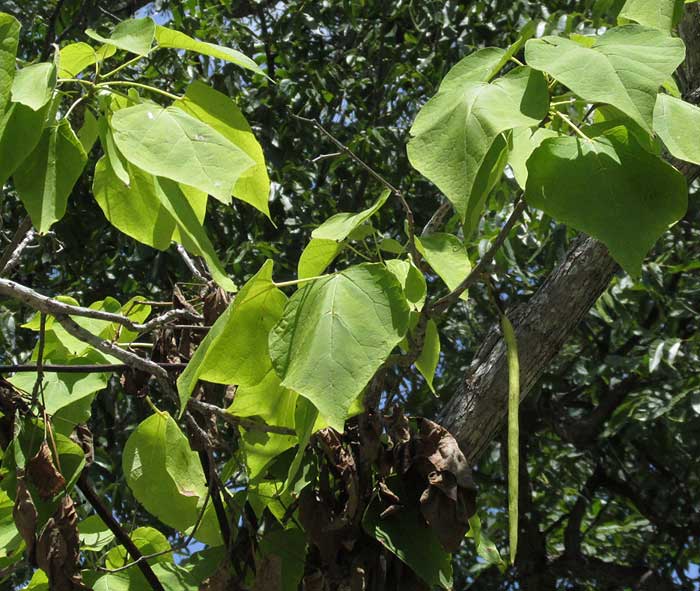Excerpts from Jim Conrad's
Naturalist Newsletter

from the August 17, 2014 Newsletter issued from the Frio Canyon Nature Education Center in the valley of the Dry Frio River in northern Uvalde County, southwestern Texas, on the southern border of the Edwards Plateau; elevation ~1750m (~5750 ft); N29.62°, W99.86°; USA
CATALPA
Along a backstreet in Uvalde a tree stood out simply because it wasn't a liveoak. It bore large, heart-shaped leaves clustered at the tips of its thick branches, and long, slender, capsular-type fruits dangled from among them, as seen above.
This is one of my favorite trees, if only because back on the farm in Kentucky where I grew up it was so common in people's backyards, and along roads and trails, despite its being disdained as a weed tree. Its wood was despised as too likely to warp and splinter, and it wasn't much good for burning. However, the hand pegs we used for setting our precious tobacco plants were carved of catalpa, probably because the wood could be whittled into peg form so easily. Back then, the main reason people kept Catalpas around their houses was that for several months of each summer the leaves hosted legions of large, juicy caterpillars that made great bait when fishing for catfish in local ponds. We never called our trees Catalpa, however; in our Western Kentucky speak, it was Patalfa, or maybe even Pataltha, according to my mother.
Two look-alike Catalpa species are native to the US. The Northern Catalpa, Catalpa speciosa, is home from Illinois through Kentucky to Tennessee and Arkansas, while the Southern Catalpa, Catalpa bignonioides, is native from Florida through the Gulf states, to Texas. The Northern produces noticeably larger leaves and flowers than the Southern. Both species have been widely planted and spread far beyond their range; there used to be one featured in a garden near where I lived in Belgium.
Catalpas are members of the large but mostly tropical Bignonia Family, the Bignoniaceae, the best-known members to North Americans probably being the woody, viney Trumpet-Creeper and Cross-Vine. Members of the family normally produce large, pretty flowers with tubular corollas, and longish fruit capsules that split at maturity to release small seeds that often bear papery wings, which help the seeds disperse on the wind. Catalpas display all these Bignonia Family field marks.
When I saw the one in the picture, in Uvalde, it struck me that its leaves seemed smaller than I remembered. That would make sense if the ones on the farm in Kentucky were the Northern species native to that area, and the one in Uvalde were the Southern species, native to eastern Texas but not this far west.
On that shaky basis, I'm guessing that the species in our picture is the Southern Catalpa, CATALPA BIGNONIOIDES.
The tree in Uvalde wasn't doing well. Some of its larger branches were dying back, apparently from the drought. I looked for "patalfa worms," as I called them as a kid, but saw none. Still, it was a real pleasure seeing a Catalpa in Uvalde.